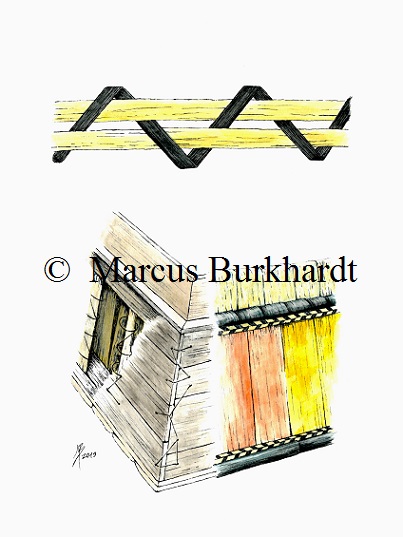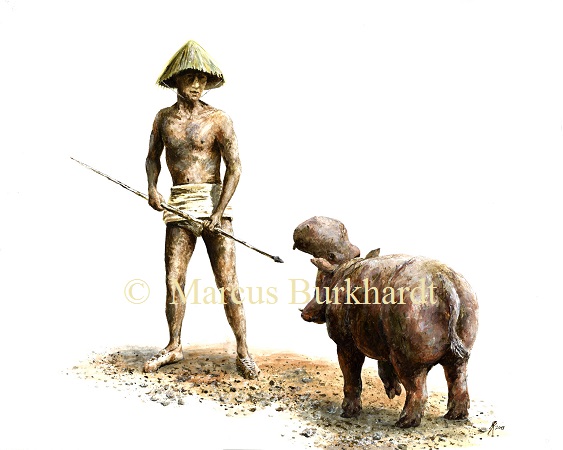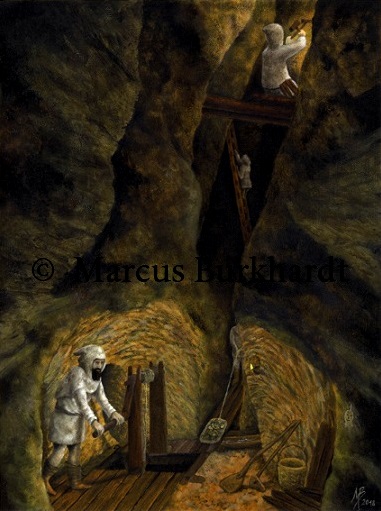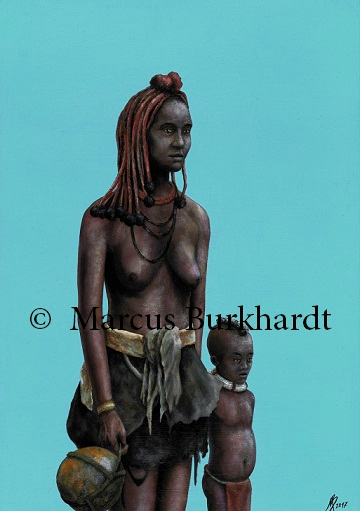
Acrylic and oil paint on panel, 2020
50 x 40 cm

Acrylic and oil paint on panel, 2020
50 x 40 cm

“Scarlet macaw”
At the Musée des Confluences in Lyon where I saw this mask it was explained that bodily adornments identify the group to which the wearer belongs: “Unlike birds which can be distinguished by their plumage, human beings do not bear specific markings of their ethnicity. Consequently the Amerindians choose the feather to distinguish their group’s cultural identity, as for them, it is a symbol of the natural order of things… The choice of feathers used to decorate adornments is one way the Amerindians have of identifying themselves with the bird world. For example, if they use juvenile down or an adult bird’s feathers it will show what age they are and what stage they have reached in their initiation… In Amazonia, the Indians of one group and those of another are perceived as belonging to different species. Tangible representations like ornaments, masks and body painting become extensions of the body, constituting a kind of species-specific costume that group’s members wear over their human forms.”
According to the museum the mask was only made from feathers of the scarlet macaw (Ara macao). It is called “Ype mask” and belongs to the tribe of the Tapirape. Further reading in ethnological literature explained the complex meaning and use in rites, as well as the need to depict the wearer with a red cloth.
Acrylic & oil paint on canvas, 2020
40 x 30 cm

Armor from the first half of the 17th century. It shows the practicable, space-saving mounting at a hook, different from the most manners of exhibition. The sketch originated at the armory in Schwarzburg/Thuringia.
Pencil, 2019
21 x 15 cm

Water bottle, powder flask and rapier from the first half of the 17th century. The sketches originated at the armory in Schwarzburg/Thuringia.
Pencil, 2019
29,5 x 21 cm

Artwork for the clarification of the buildup of divers boxes from north Sulawesi, which are made from several plant materials. Inserted are thin wooden strips, which are connected with fibers and covered with partly dyed leaves. The leaves and fibers originate probably from the palmyra- or doub palm (Borassus flabellifer) and talipot palm(Corypha umbraculifera). The skew in the upper part comes from a slip lid, which is not shown here. The sketch above shows the buildup of the both braided tapes, which are visible on the outside of the boxes as ornament.
The boxes date likely in the 19th century and were probably used to contain betel nuts (called “Sirih” by the locals). As usually, they were from different size to store and transport them interleaved.
Watercolor and ink, 2019
32 x 24 cm
Contribution for the documentary about a restoration of four boxes from north Sulawesi, conducted by Alice Costes in the degree course for conservation and restoration of archaeological, ethnological and handicrafted objects at the National Academy of Fine Arts Stuttgart.

Cyprus in the Mesolithic: A man hunts a Cyprus dwarf hippopotamus (Hippopotamus minor). This was a relative to the modern hippo (Hippopotamus amphibius) and characterized by a special foot-anatomy which made it walking on just two toes per foot and was an adaption to a more terresric way of life. This specialized hippo became extinct very fast after the arrival of humans on prehistoric Cyprus.
Acrylic paint on paper, 2019
50 x 40 cm

Medieval mine. In the foreground there is a pitman at the bobbin, on the right tools like shovel, bucket and hoe. Further backward a worker is transporting ore in a hutch. Above there is a pitman on a ladder and someone working with the “Gezähe” (hammer and chisel).
Oil paint on paper, 2018
32 x 24 cm
Client: Landesamt für Archäologie Sachsen (LfA)

Medieval mining settlement. In the foreground there is a mine shaft with bobbin. Workers stamping the ore aside. Farther behind there are a forge, an assay furnace, an ore roasting furnace, the dwellings of the miners, a charcoal pit and a Waldhufendorf. The merchants in the foreground show that these villages were provided with aliment from outside and that they had no own food production.
Oil paint on paper, 2018
32 x 24 cm
Client: Landesamt für Archäologie Sachsen (LfA)

Placer terrain in the Bronze Age. In late autumn tin panning is practiced with timber channels and wooden boxes. Below older mining waste tips are overgrown with vegetation. Left above there are primitive dwellings of the diggers.
Oil paint on paper, 2018
40 x 30 cm
Client: Landesamt für Archäologie Sachsen (LfA)
Published in: Johann Friedrich Tolksdorf: Mittelalterlicher Bergbau und Umwelt im Erzgebirge. Eine interdisziplinäre Untersuchung (Mit Beiträgen von Mathias Bertuch, Christoph Herbig, Heide Hönig, Knut Kaiser, Anja Kaltofen, Petr Kočar, Sonja Matson, Libor Petr, Tobias Scharnweber, Frank Schröder und Matthias Schubert). ArchaeoMontan (4) (Dresden 2018).

St. Bartholomäus and St. Nikolaus church in Ziegenrück, originally from the 13th century.
Ink, 2018
24 x 16 cm

Old wool spinning mill in Ziegenrück. Today it is part of the museum for hydrodynamic power.
Ink, 2018
24 x 16 cm

Medieval keep near Ziegenrück. The building was constructed in the 15th century and is a relict of the former castle of Ziegenrück.
Watercolour, 2018
24 x 16 cm

Renaissance houses in Ziegenrück (Thuringia). The left one shows the date 1546.
Oil paint on paper, 2018
40 x 30 cm

Ötzi
Oil paint on paper, 2018
32 x 24 cm
The picture originated during the symposium “Kunst am Berg”, Panoramarestaurant BergDiamant Fiss/Austria.

For research I used the following publication: Gisela Völger: Die Tasmanier: Versuch einer ethnographisch-historischen Rekonstruktion; Wiesbaden, Steiner,1972
29,5 x 21 cm

Himba woman with child and gourd
Oil paint on cardboard, 2017
42 x 29,5 cm

Pappenheimer, a type of armor named after Gottfried Heinrich zu Pappenheim (1594-1632), a general of the Thirty Years’ War.
Watercolour, 2018
32 x 24 cm
The picture originated at the Dresden Armory.

The chapel St. Anne in Krobitz in the district Saale-Orla was primary a Romanic building from the 12th century and was rebuilt in 1610/11.
Ink, 2018
21 x 15 cm

Reconstruction of the Wysburg, view from southwest
Ink, 2017
59,5 x 42 cm
Client: Weisbach e.V.
Published in: C. Tannhäuser, H. Roßbach: Die Wysburg bei Weisbach im Thüringer Schiefergebirge. Archäologische Denkmale in Thüringen Band 4, 2018

Reconstruction of the Wysburg, view from northeast
Ink, 2017
59,5 x 42 cm
Client: Weisbach e.V.
Published in: C. Tannhäuser, H. Roßbach: Die Wysburg bei Weisbach im Thüringer Schiefergebirge. Archäologische Denkmale in Thüringen Band 4, 2018

Kalmyk yurts, south-western Russia
Acrylic paint on paper, 2017/18
32 x 24 cm

Tōrō, a lantern made of granite which was used in Japanese Buddhist temples first, can be seen also in Japanese gardens since a few centuries..
Pencil, 2018
29,5 x 21 cm
The drawing originated at the Lindenmuseum in Stuttgart.

Stone statue from Hawai’i, 19th century. Such images depicted personal tutelary deities (aumakua), which were venerated even also after the Christianization, mainly by fishermans .
Pencil, 2017
29,5 x 21 cm
The drawing originated at the Lindenmuseum in Stuttgart.


Buddhistical monk
Acrylic paint on paper, 2017
48 x 36 cm

Ancestor skull, drawn in the Musée de l’Homme in Paris
Pencil, 2017
29,5 x 21 cm

Mortar of 1617, drawn in the Dresden City Museum
Pencil, 2017
21 x 15 cm

Sketched apse of the church St. Mathilde in Quedlinburg, a building of the Gothic Revival
Ink, 2017
21 x 15 cm

Sketch of a house in Quedlinburg
Pencil, 2017
21 x 15 cm

The former home of the executioner at the Finstertor in Görlitz (today it is the domicile of a Saxon workcamp) has a solid ground floor made of dressed stone. A timber frame construction in a Franconian style forms the upper floor, where potentially the flat was placed. The executioner of Görlitz moved to this place in 1571, after he residenced within the town, and not outside of the surrounding wall where the depicted house is located. At the house wall showing to the road there is a tablet with the inscription “1666 L. S. B.”, which is pointing to the best known executioner of Görlitz named Lorenz Straßburger. At the lower gable end there is a second tablet with the inscription “Im Jahre Christi A • 1676 | L•S•B” and a drawing of a sword.
Watercolour, 2017
32 x 24 cm

Encounter with Aepyornis maximus
A Madagasy man of the Bara type faces a bird which extinction is caused by his species: elephant birds, also known as vorompatras, belong to the biggest birds of Earth history and lived probably until the 17th century. Anyway this bird has an importance for the natives until today: the shells of the big eggs are collected and sold to tourists. The aborigine has a gusset hairstyle, which was still a distinctive feature between the different clans of Madagascar a hundred years ago. The hair gussets were often covered in a layer of wax.
Coloured pencil, 2016/17
59,5 x 42 cm
MoVo – Moderne Vogelbilder, 2017, Heineanum Halberstadt

The Hausmannsturm is part of the Dresden Castle and today it is over 100 metres high. The bottom has its seeds around 1400, the upper part in its contemporary style was built in 1674-76. As a result of the bombing of Dresden at the end of the Second World War the tower has lost its roof, which was rebuilt only 1991. The small hand of the clock is the minute hand, the big one the hour hand according to the historical example.
Watercolor, 2017
48 x 34 cm

Reconstruction proposal for the Upper Court of the Castle of the Advocates of Plauen in Vogtland, 13th-15th century AD
Pencil, 2015/16
29,5 x 21 cm
Preview for a publication about archaeological excavations and written records of the Castle of the Advocates of Plauen

Stone Age in Vietnam: Hoabinhian or Hòa Bình culture
Coloured pencil, 2016
42 x 29,5 cm
Published in: I. Kraft, J. F. Tolksdorf, Archäologie | Vietnams Altsteinzeit als Bambuszeit?, Spektrum der Wissenschaft, October 2017, 70-77.

Portrait of a young Frenchwoman
Coloured pencil, 2016
29,5 x 21 cm

Slavonian village in the Early Middle Ages
Coloured pencil, 2015
59,5 x 42 cm
Sachsens Geschichte unterm Acker – Landwirte schützen Denkmale, 2015, Sächsischer Landtag www.archaeologie.sachsen.de/5822.htm

Mesolithic shaman with antler frontlet, lynx fur and bodypainting. Headdress like this was found in many parts of Europe. If they were used for cultic functions or drafted for going deerstalking is vague. Certainly there were similar masks by shamans in Siberia till the recent past.
Coloured pencil, 2015
59,5 x 42 cm
Sachsens Geschichte unterm Acker – Landwirte schützen Denkmale, 2015, Sächsischer Landtag www.archaeologie.sachsen.de/5822.htm

Woman of Bronze age, according to a hoard of Kyhna in Saxony (2100 BC), Únětice culture
Coloured pencil, 2015
65 x 50 cm
Sachsens Geschichte unterm Acker – Landwirte schützen Denkmale, 2015, Sächsischer Landtag www.archaeologie.sachsen.de/5822.htm

Collar of the Blackfoot from the middle of the 19th century. It consists of bison leather (Bos bison) and is adorned with claws of the grizzly bear (Ursus arctos horribilis) and pearls. The collar is arranged in the Karl-May-Museum in Radebeul.
Pencil, 2016
29,5 x 21 cm

Maya warrior
Pencil, 2012
59,5 x 42 cm

Papuan and offensive cassowary (Casuarius casuarius)
Ink, 2014
70 x 50 cm
MoVo – Moderne Vogelbilder, 2015, Heineanum Halberstadt

Human skull
Watercolor, 2015
42 x 29,5 cm